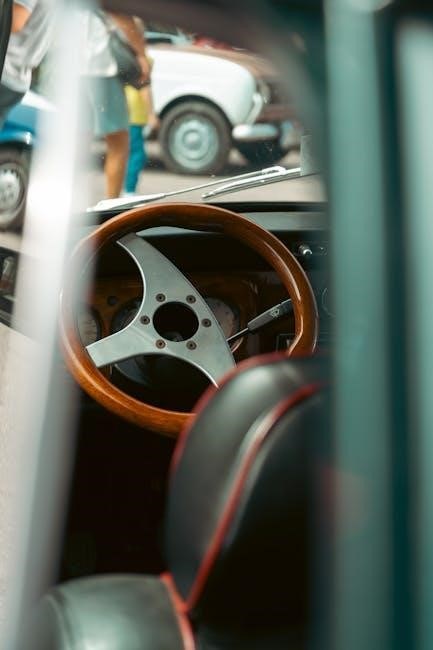Welcome to the Fender Champion 100 Manual‚ your comprehensive guide to unlocking the full potential of this versatile amplifier․ This manual covers essential safety precautions‚ controls‚ and features‚ ensuring optimal performance and ease of use․ With detailed instructions and troubleshooting tips‚ it’s designed to help both beginners and experienced musicians make the most of their amplifier․ Rated highly by users‚ this manual provides clear‚ concise information to enhance your musical experience․
1․1 Overview of the Fender Champion 100 Amplifier
The Fender Champion 100 is a versatile and powerful guitar amplifier designed for both practice and stage use․ It delivers 100 watts of output through a single 12-inch speaker‚ offering clear and robust sound․ The amplifier features multiple channels‚ built-in effects‚ and a user-friendly interface‚ making it ideal for musicians seeking flexibility․ Its compact design and lightweight construction ensure easy portability‚ while the rugged build guarantees durability․ With its rich tone and versatility‚ the Champion 100 is a popular choice among guitarists of all skill levels‚ providing exceptional value for its performance capabilities and features․
1․2 Importance of Reading the Manual
Reading the Fender Champion 100 manual is essential to fully understand and utilize the amplifier’s features․ It provides detailed instructions on operating the controls‚ optimizing settings‚ and troubleshooting common issues․ The manual also outlines safety precautions to prevent damage or injury‚ ensuring safe and proper use․ By familiarizing yourself with the manual‚ you can unlock the amplifier’s full potential‚ avoid misunderstandings‚ and maintain its performance over time․ It serves as a comprehensive guide for both beginners and experienced users‚ helping you get the most out of your Fender Champion 100 experience․
1․3 Structure of the Manual
The Fender Champion 100 manual is organized into clear‚ logical sections to ensure easy navigation․ It begins with an introduction‚ followed by safety precautions‚ installation‚ and operation details․ Subsequent chapters cover controls‚ features‚ specifications‚ and troubleshooting․ Each section is divided into subheadings‚ providing in-depth information on specific topics․ The manual concludes with maintenance tips and resources for further support․ This structured approach allows users to quickly locate relevant information‚ making it an indispensable guide for both setup and ongoing use of the amplifier․ The clear layout ensures a smooth learning and operating experience for musicians of all skill levels․

Safety Precautions
The Fender Champion 100 manual emphasizes critical safety measures to prevent accidents․ Always avoid exposure to water‚ ensure proper ventilation‚ and handle electrical components with care․ Never overload outlets‚ keep the amplifier away from flammable materials‚ and avoid extreme temperatures․ Regularly inspect cables and connectors for damage․ Unplug the unit before cleaning or servicing․ Failure to follow these guidelines may result in injury‚ damage‚ or void the warranty․ Prioritize safety to ensure optimal performance and longevity of the amplifier․
2․1 General Safety Guidelines
To ensure safe operation of the Fender Champion 100‚ always follow these guidelines․ Keep the amplifier away from water and moisture to prevent electrical hazards․ Avoid blocking ventilation openings‚ as this can cause overheating․ Use only the correct power source and avoid overloading circuits․ Never operate the amplifier near open flames or sparks․ Check for damage to cords or plugs before use and avoid using the unit if damaged․ Do not attempt unauthorized repairs‚ as this can void the warranty and pose safety risks․ Store the amplifier in a cool‚ dry place and keep it out of reach of children․
2․2 Electrical Safety
Always use the correct power source and voltage rating specified for the Fender Champion 100 to prevent damage or electrical hazards․ Ensure the power cord is undamaged and properly plugged into a grounded outlet․ Avoid overloading circuits with multiple high-power devices․ Never expose the amplifier to moisture or operate it in humid environments‚ as this can increase the risk of electrical shock․ Keep the plug and cord away from water and ensure they remain dry during use; If the amplifier is not in use‚ unplug it to prevent standby power consumption and potential electrical issues․
2․3 Handling and Storage Tips
Handle the Fender Champion 100 with care to prevent damage․ Always lift the amplifier using both hands‚ supporting the bottom to avoid straining the handle or cabinet․ Avoid exposure to extreme temperatures or humidity‚ as this can harm the electronic components․ When storing‚ place the amplifier in a dry‚ cool environment‚ preferably in its original packaging or a protective cover․ Clean the unit regularly with a soft cloth to prevent dust buildup․ Never stack heavy objects on top of the amplifier‚ as this could cause permanent damage to the speakers or internal circuitry․ Store it upright to ensure proper ventilation and stability․

Installation and Setup
Proper installation ensures optimal performance․ Begin by unboxing and inspecting the amplifier for damage․ Place it on a stable‚ flat surface away from direct sunlight․
3․1 Unboxing and Initial Inspection
Start by carefully unboxing the Fender Champion 100 amplifier and accessories․ Inspect the unit for any visible damage or scratches․ Check that all items‚ including the power cord‚ guitar cable‚ and manual‚ are included․ Ensure the amplifier is placed on a stable surface before plugging it in․ Examine the control panel‚ speakers‚ and ports for proper functionality․ If any damage or missing items are found‚ contact Fender Support immediately․ Proper inspection ensures safe and optimal operation․
3․2 Placing the Amplifier
Position the Fender Champion 100 on a sturdy‚ flat surface‚ ensuring stability․ Avoid tilting or laying the amplifier horizontally to prevent damage․ Keep it at least 6 inches away from walls or other objects for proper ventilation․ Place it in a well-ventilated area to avoid overheating․ Ensure the amplifier is not exposed to direct sunlight‚ moisture‚ or extreme temperatures․ Avoid placing it near flammable materials․ Secure the amplifier to prevent accidental movement during use․ Proper placement ensures optimal performance‚ safety‚ and longevity of the unit․
3․3 Connecting the Guitar and Other Instruments
To connect your guitar‚ plug a high-quality instrument cable into the amplifier’s input jack․ Ensure the cable is securely inserted to avoid signal loss․ For multiple instruments‚ use the auxiliary input or external channels if available․ Adjust the volume on your guitar and the amplifier to achieve the desired sound․ For additional instruments like keyboards or bass‚ use the appropriate input channels․ Always use a high-quality cable to minimize interference․ Test the connection by playing your instrument to ensure proper functionality․ Refer to the manual for specific input configurations and compatibility with other devices․

Understanding the Controls
This section helps you familiarize yourself with the amplifier’s controls‚ enabling you to adjust settings and customize your sound effectively․ Master the knobs and buttons for optimal performance․
4․1 Channel Selection and Volume Controls
The Fender Champion 100 features a straightforward channel selection system‚ allowing you to switch between clean and various gain-based channels using the dedicated channel button․ Each channel is equipped with its own volume control‚ enabling precise adjustment of your sound’s intensity․ The clean channel’s volume knob ensures crisp‚ undistorted tones‚ while the gain channels provide a range from subtle overdrive to heavy distortion․ Additionally‚ the master volume control lets you set the overall output level‚ maintaining clarity even at lower settings․ Properly balancing these controls is key to achieving your desired sound without compromising quality or dynamics․
4․2 Tone and EQ Settings
The Fender Champion 100 offers a comprehensive tone-shaping system through its 3-band EQ‚ featuring Bass‚ Middle‚ and Treble controls․ These allow precise adjustment of low‚ mid‚ and high frequencies to tailor your sound․ The Presence control further refines the high-end response‚ adding clarity and definition․ Players can experiment with these knobs to achieve a wide range of tonal possibilities‚ from warm‚ vintage tones to bright‚ modern sounds․ The EQ settings are independent for each channel‚ ensuring versatility and customization for different playing styles and musical genres․ Properly adjusting these controls can significantly enhance the overall quality and expressiveness of your playing experience․
4․3 Effects and Reverb Controls
The Fender Champion 100 features a robust selection of built-in effects‚ including Reverb‚ Delay‚ Chorus‚ Overdrive‚ and Tremolo․ These effects are easily accessible via dedicated buttons‚ allowing you to enhance your sound without the need for external pedals․ The Reverb control adjusts the level of ambiance‚ from subtle room tones to expansive hall-like reverberations․ The Effects Level knob sets the intensity of the selected effect‚ ensuring seamless integration with your tone․ Additionally‚ the Tap button enables precise adjustment of delay times and other time-based effects․ These controls provide exceptional versatility‚ enabling you to craft a wide array of sounds to suit any musical style․

Features of the Fender Champion 100
The Fender Champion 100 is a versatile amplifier offering dual channels‚ built-in effects‚ and auxiliary plus headphone jacks for enhanced functionality and convenience․
5․1 Built-in Effects and Their Functions
The Fender Champion 100 features a wide range of built-in effects‚ including reverb‚ delay‚ chorus‚ tremolo‚ and distortion․ These effects allow players to enhance their sound without external pedals․ The reverb adds spatial depth‚ while delay creates echo-like repetitions․ Chorus thickens the tone‚ and tremolo provides rhythmic volume modulation․ Distortion offers a gritty‚ overdriven sound․ Each effect is easily adjustable using dedicated controls‚ enabling musicians to tailor their tone to suit various genres and playing styles․ This versatility makes the Champion 100 ideal for practice‚ recording‚ and live performances‚ catering to both beginners and experienced guitarists․
5․2 Channel Switching and Versatility
The Fender Champion 100 offers seamless channel switching‚ allowing players to transition between clean and overdrive channels effortlessly․ This feature enhances versatility‚ enabling musicians to adapt to various musical genres and playing styles․ The clean channel delivers crisp‚ natural tones‚ while the overdrive channel provides a rich‚ distorted sound for heavier riffs․ A footswitch is included for convenient switching during performances․ This dual-channel design‚ combined with the amplifier’s built-in effects‚ makes it highly adaptable for both live gigs and practice sessions‚ catering to a wide range of musical preferences and needs․
5․3 Auxiliary and Headphone Jacks
The Fender Champion 100 features an auxiliary input jack and a headphone jack‚ offering convenient options for practice and playback․ The auxiliary input allows players to connect external audio devices‚ such as MP3 players or phones‚ to play along with their favorite tracks․ The headphone jack enables silent practice‚ ideal for home use or late-night sessions without disturbing others․ These jacks enhance the amplifier’s versatility‚ making it suitable for both rehearsal and performance environments․ They provide flexibility for musicians to adapt to various playing situations while maintaining high-quality sound output․

Specifications
The Fender Champion 100 delivers 100 watts of power through a single 12-inch Celestion speaker‚ weighing 22․4 pounds with dimensions of 20․4 x 11․3 x 21․2 inches․
6․1 Power Output and Speaker Size
The Fender Champion 100 is equipped with a robust 100-watt power output‚ delivering ample volume for rehearsals‚ performances‚ and recording sessions․ It features a single 12-inch Celestion speaker‚ designed to provide clear and balanced tone reproduction across various musical genres․ The combination of power and speaker size ensures a strong‚ resonant sound that maintains clarity even at higher volumes․ This configuration makes the amplifier versatile‚ suitable for both clean and overdriven settings‚ while remaining portable for musicians who need reliable performance without compromising on sound quality or versatility․
6․2 Weight and Dimensions
The Fender Champion 100 weighs approximately 40 pounds‚ making it portable yet sturdy for gigging musicians․ Its dimensions are roughly 19 inches in height‚ 23 inches in width‚ and 10 inches in depth‚ ensuring it fits neatly in most vehicles and performance spaces․ These measurements strike a balance between durability and portability‚ allowing easy transport without compromising on the amplifier’s robust build․ The compact design also makes it space-efficient for home use or studio settings‚ catering to a variety of musical needs․
6․4 Compatibility with Additional Gear
The Fender Champion 100 is designed to integrate seamlessly with a variety of musical equipment․ It features an auxiliary input for connecting external audio sources‚ such as phones or music players‚ allowing for easy playback and practice sessions․ Additionally‚ the amplifier includes a headphone jack for silent practice and a line-out for recording or connecting to a PA system․ Its 1/4-inch guitar input ensures compatibility with standard guitar cables‚ while the built-in effects and channel switching enhance versatility․ This flexibility makes the Champion 100 a versatile choice for rehearsals‚ performances‚ and home studios․

Operating the Amplifier
Power on the amplifier using the main switch‚ set the volume to your desired level‚ and adjust the tone controls for optimal sound quality․
7․1 Turning On and Off
To power on the Fender Champion 100‚ locate the power switch on the back panel and flip it to the “on” position․ Allow a few seconds for the amplifier to warm up․ The power LED will illuminate‚ indicating the amp is ready for use․ When not in use‚ turn the power switch to the “off” position to conserve energy and extend the amp’s lifespan․ Always ensure the volume is set to zero before turning on or off to prevent sudden loud noises․ Proper power management helps maintain the amplifier’s performance and longevity․
7․2 Adjusting Settings for Optimal Sound
Start by setting all controls to their neutral positions․ Adjust the volume to a comfortable level‚ then fine-tune the EQ settings (bass‚ mid‚ and treble) to achieve your desired tone․ The reverb level can be adjusted to add depth to your sound․ Experiment with the channel settings to match your playing style․ For clean tones‚ keep the gain low; for overdriven sounds‚ increase it gradually․ Use the guitar’s volume knob to further refine your tone․ Test different settings with various guitars or effects pedals to find the optimal configuration for your music․ Refer to the manual for detailed guidance on customization․
7․3 Using the Built-in Effects
To utilize the built-in effects‚ select the desired effect type using the effect selector button on the control panel․ Adjust the effect level knob to set the intensity of the effect․ For reverb‚ experiment with the level to achieve the perfect ambient sound․ Delay and distortion can be fine-tuned for precise tonal shaping․ Use the tap button for delay tempo synchronization․ Ensure the effects are engaged by checking the LED indicator․ Mix and match effects to create unique sounds‚ and refer to the manual for detailed instructions on each effect’s functionality․ This feature enhances versatility and creativity during performances or practice sessions․

Troubleshooting Common Issues
Troubleshoot issues like no sound‚ distortion‚ or overheating by checking connections‚ ensuring proper setup‚ and consulting the manual for specific solutions to restore optimal performance quickly․
8․1 No Sound or Distorted Sound
If your Fender Champion 100 is producing no sound or distorted sound‚ check the volume levels‚ ensure all cables are securely connected‚ and verify that the correct input channel is selected․ Make sure the mute function is not engaged and that the EQ settings are balanced․ If distortion persists‚ adjust the gain and volume controls to avoid overload․ Check for blown fuses or damaged cables‚ and ensure the amplifier is properly ventilated․ If issues remain‚ consult the manual or contact Fender support for assistance․ Regular maintenance can help prevent such problems and maintain optimal performance․
8․2 Overheating Issues
If the Fender Champion 100 amplifier overheats‚ ensure proper ventilation by keeping it away from walls or obstructions․ Avoid blocking the rear and top vents‚ as this can impair cooling․ Reduce volume levels during extended use to prevent excessive heat buildup․ Check for dust accumulation and clean the vents periodically․ Never operate the amplifier in direct sunlight or high-temperature environments․ If overheating occurs‚ turn it off immediately and allow it to cool․ If the issue persists‚ inspect for faulty internal components or blockages․ Consult a professional technician to address any internal cooling system malfunctions․ Always follow the manual’s guidelines for safe operation․
8․3 Faulty Controls or Buttons
If the Fender Champion 100’s controls or buttons malfunction‚ first ensure they are clean and free from debris․ Use compressed air to gently remove dust from knobs and buttons․ If a knob is loose‚ tighten it securely․ For stuck buttons‚ press and release them firmly to reset their alignment․ Avoid using excessive force‚ as this may damage the internal components․ If the issue persists‚ inspect for loose connections or corrosion․ Consult the manual for wiring diagrams or contact Fender support for assistance․ Do not attempt complex repairs without professional guidance to prevent further damage to the amplifier․

Maintenance and Repair
Regular maintenance ensures optimal performance․ Dust the amplifier with a soft cloth and use compressed air for vents․ Check cables and connections for wear․ Inspect speakers and ensure proper ventilation to prevent overheating․ For repairs‚ consult the manual or contact Fender support․ Avoid DIY fixes without professional guidance to maintain warranty and safety․ Schedule periodic professional servicing for internal components․ Keep the amplifier in a dry‚ cool environment to prolong its lifespan and reliability․
9․1 Cleaning the Amplifier
To maintain your Fender Champion 100‚ clean it regularly․ Turn off the amplifier and let it cool․ Use a soft‚ dry cloth to wipe the exterior‚ removing dust and dirt․ For vents‚ use compressed air at a low setting to avoid damaging internal components․ Avoid harsh chemicals or damp cloths‚ as they may harm the finish or cause electrical issues․ Never touch the speaker cones; instead‚ use a dry cloth to gently remove dust․ Cleaning ensures optimal performance and prevents dust buildup․ Regular maintenance enhances reliability and preserves the amplifier’s appearance․ Always handle the amplifier with care to avoid scratches or damage․
9․2 Checking and Replacing Fuses
To ensure your Fender Champion 100 operates smoothly‚ regularly inspect the fuses․ Locate the fuse compartment‚ usually at the rear or bottom of the amplifier․ Turn off the amp and let it cool before accessing․ Remove the compartment cover and examine the fuses for signs of damage or blowing․ Replace blown fuses with the correct type and rating‚ as specified in the manual or fuse compartment․ Never use a fuse with a higher rating‚ as it may cause damage․ Reinstall the cover and test the amplifier․ If unsure‚ consult a professional; Proper fuse maintenance ensures reliable performance and sound quality․
9․3 Professional Servicing Recommendations
For complex repairs or maintenance beyond basic care‚ consult an authorized Fender service center․ Professional servicing ensures your Champion 100 operates at peak performance and maintains its warranty․ Technicians are trained to handle advanced issues‚ such as circuit repairs or upgrades‚ using genuine Fender parts․ Avoid DIY repairs for critical components to prevent irreversible damage․ Regular professional checkups can prevent potential issues and extend the amplifier’s lifespan․ Always verify the qualifications of the service provider to ensure reliable and high-quality work․ Professional servicing is essential for preserving your amplifier’s sound quality and functionality․

Resources and Support
Fender offers extensive resources to support your Champion 100 experience․ Visit the official Fender website for manuals‚ FAQs‚ and troubleshooting guides․ Contact Fender customer support for direct assistance․ Engage with online forums and communities for tips and advice from fellow musicians․ These resources ensure optimal performance and address any queries or concerns effectively․
10․1 Downloading the Manual
The Fender Champion 100 manual is readily available for download on Fender’s official website․ Navigate to the Support section‚ where you can search for your specific model․ Ensure you select the correct version corresponding to your amplifier․ The manual is typically provided in PDF format‚ allowing easy access on any device․ Downloading the manual ensures you always have a digital copy for reference․ Regularly check Fender’s website for updated versions‚ as improvements or additional information may be added․ This convenient option keeps you informed and helps you make the most of your Champion 100 amplifier․
10․2 Fender Customer Support
Fender offers comprehensive customer support to assist with any questions or issues regarding the Champion 100 amplifier․ You can reach their support team via phone‚ email‚ or live chat through their official website․ The support page also provides resources like FAQs‚ troubleshooting guides‚ and repair center locations․ Fender’s dedicated team ensures timely and professional assistance‚ helping you resolve issues or understand features better․ Whether you need technical help or general inquiries‚ Fender’s customer support is a reliable resource to enhance your experience with the Champion 100․ Their commitment to customer satisfaction makes them a trusted partner for musicians worldwide․
10․3 Online Forums and Communities
Online forums and communities are invaluable resources for Fender Champion 100 users․ Platforms like Fender’s official forum‚ Reddit‚ and Facebook groups offer spaces to discuss tips‚ share experiences‚ and troubleshoot issues․ Musicians often exchange advice on optimizing amp settings‚ effects usage‚ and maintenance․ These communities foster collaboration and learning‚ allowing users to enhance their skills and resolve common problems collectively․ Engaging with these forums provides access to a wealth of knowledge and practical insights from experienced players and technicians․ They serve as a vibrant support network‚ ensuring you get the most out of your Fender Champion 100 amplifier․
